e.Republic: An improvement community in progress Alan Cox. 1.* - unedited transcript - Good Afternoon. It is nice to be here today. I have a long-standing relationship with Doug through my father. He and my father worked together years ago at SRI when it still was the Stanford Research Institute, before it became the SRI International. I lived in Palo Alto; I was born on the campus, my parents both graduated from Stanford. Across the way at Palo Alto high school, that is where I used to come bowl when I was in high school. It is nice to be back here, I would love to live here, but you all need
to do something about the pricing, Sacramento is a lot more affordable.
I work at eRepublic, for a publishing company. We are an improvement
community. I am going to tell you about what our company does. I will tell
you about the area that we work within, and what are the statistics of
the area are. I'll talk about the trends that we are in and the improvement
opportunities that are there.
So eRepublic, we publish all sorts of things we publish a national magazine, a government technology magazine. This is been a something that we published for thirteen years; it is sponsored by industry advertisements. It is free to anyone who wants to subscribe. It's all about what are state local governments in the states and other parts of the country, doing with technology to solve their business problems. In government, you are dealing with a community that is very much a knowledge community. If you take correctional, officers out you take the department of transportation people who are out fixing freeways, and engineering. You have primarily knowledge workers. Social worker, caseworkers, people who are dealing with criminal justice dealing with law. It is very much a knowledge group that you are working with. We also publish a magazine; this is a very new one called Converge Magazine. Converge is all about the converge between technology and education at all levels. From the K-12 point of view higher Ed, life long learning. All sorts of money are coming into education to buy technology. For the most part educational institutions are not aware of the value of technology in educating. Here we have a web cast going on and this is a very innovative way of using the technology, but where does a kindergarten teachers use a PC and where do they use that in their classroom? We talk about some of that. We also found that there was a problem about some of the people who sell to govt. They don't understand whom they are selling to, they don't understand what government is about, and they don't understand the politics. They don '92t understand the budgeting or the dynamics of the organization. There is a huge difference between the public sector and the private sector that we will get into. We also publish our editorial information in the form of conferences and events. This week we're in Austin, Texas for the entire week with about fifty classes, seminars, tutorials, and keynote speakers. Three hundred and fifty exhibitors and a large trade show that is called the Government Technology Conference Southwest. It is for the region around Texas. We do one in California in Sacramento that has about twenty two thousand people attend annually. We also do one in Albany, New York. As you will see from one of my slides, these are the three largest states in terms of IT budget and employment. The Center for Digital Government, I will talk about this more, which is our main effort right now to act as an improvement community. Since we do publish, we are talking about a very linear way of reaching people. We can gather information from all around the country, as to what is going on in NY, what is going on in Albany, what is going on in New York City, what may be going on in Iowa or Idaho. But we can only publish that very linearly, once a month or talking to people in a classroom setting, or at one of our conferences or executive level events. So, the Center for Digital Government is our effort to improve with how we actually provide people with access to our information. The government. There are fifty states in the United States.
Someone published a thought that the fifty-first state might be a cyber state. There are five territory numbers of counties in total about 87,000 different governmental organizations are this country. That is a pretty sizeable group. If you are talking about scaling, which Doug mentioned very early on, you are talking about cities that have a very small number of people. Where I live in the foothills, in a very small town call Georgetown. It is about fifty miles from Sacramento and about forty miles from our office in Folsom. It's a very small community, we don't have a sheriffs department, and we don't have a police department. We have a volunteer fire department. It's your traditional small community in the gold country of California. When you compare that to New York City, well, NYC's annual budget is as large as anyone in the four to one hundred. So, in dealing with the use of technology in government, the scaling of what people do in California is that you might have fifty people doing the automated process, which Rhode Island has two people doing part-time manually. There are very different ways that people are handling all of the data and services that they provide for government organizations.
Government employment is huge. You may not realize how many people are
employed in government. Here I show 12.4 million people in local government,
4.6 in state, 2.7 in federal civilian and 1.5 million in federal military.
If you start looking at this 16 states are in the fortune 100 in terms
of their operating budget. California is in the top ten. All fifty
states are in the Fortune 500.
12.5% of the United States workforce is employed in the government organization. 10% of the US IT spending. In the government marketplace. It is the largest vertical if you are a marketer or salesperson, compared to legal, banking, or one of the various vertical markets that the computers industry sells to. $55.8billion in IT spending. It is a huge amount of money spent by government to automate what they are doing in a lot of ways. Unfortunately, you read about the areas where the government is having
challenges. California has had many notable ones; I hate to mention the
one. That is not the very biggest DMV failure in the county. You can go
to a state just north of us to a state that had an even more expensive
failure in their DMV system. California correctional management information
system was also shown. Very expensive. You are dealing with millions of
dollars of effort. California's state wide automated welfare system.
Another problematic system. Every state in the country is grappling with
these kinds of situations. California just has a problem of being
so huge and so vast with so many people the number of motor vehicles, so
it is a staggering issue of how you apply the technology. You could
find all of these great lessons learned from other parts of the country,
but looking at how Wyoming automates it's motor vehicle system compared
to how Cal automates their motor vehicle system. The scale is tremendously
different. You can talk all of Los Angeles County and say well we
still have more cars than Wyoming. So there are some challenges that the
government faces. So, what is going on now? This is where I think
that it gets to be interesting in terms of technology. I have a few quotes
for you.
This is Joe Thompson, former CIO of US General Services Administration. "Right now you should now that state spending on it is accelerating at four times the rate of federal spending. The reason is simple, that the federal agencies are discontinuing activities and giving them to the states and cities. This is a major move. Local state government is being asked to provide these services. This creates quite a challenge. Where you had one group providing the services, now you have fifty, in the case of states. Or 87,000 in the case of towns. Towns are growing. There will be 5% more towns at the end of these years than there were at the start of the year. More and more are springing up everywhere and they are being asked to provide services that the federal government used to provide. If you look at any part of the private sector, let's take a Home Depot as an example. You don't go to the Home Depot to buy a hammer, the go across the street to the Nails R Us to buy the nails. Then to Wood MI to buy wood. You go to one place to buy all this. Well in government instead of having the government provide all this, instead they say let's cut taxes, and let's have the states and the cities and counties provide all this. The state does this in the same way to the counties. The state says were going to lower taxes, then they grab tax money back from the counties and they say but you are still going to provide the services that you are providing. There are some interesting paradoxes here. Money is being pushed down to the state and local level; this has been going on for some time this is why we focused in on this area. It's where most of the technology spending is happening at the state and local level.
Well what is going on? Well we have a large digital economy that is going on, certainly in Silicon Valley. The e stuff is definitely the buzzword. My brother and sister are very involved in this kind of community. I'm sure that you all are to some degree. The culture is changing dramatically, Don Taft cost writes about this in his book, Growing Up Digital. Kids who grew up with toys and computers more powerful then the general who neither used to command nor had at his disposal. All of this is impacting right at the middle of government, education, and manufacturing and banking. The bottom three of those have definitely taken advantage of that. You look at a Dell computer organization or a SYSCO who have taken the intranet tech and used it and used it to streamline their processes and their efficiency from end to end. Now governments don't necessarily work that way. Not to say that is the focus of government but to say that I am going to replace everything, one you don't have the budget to do that. Two you don't have the political will to do that. You don't have a CEO that can say oh no this is what we are doing like it or not Mr. or Mrs. Employee. So, what you have is the deliberate tempo of government running headlong into a world running on Internet time.
This is from Steve Kolodney who is the chief officer of the state of Washington. Washington is a very progressive state in terms of technology. They actually have a statewide infrastructure that is as sophisticated as any private sector. All of the cities, all of the counties, public education institutions, all of libraries, and law enforcement have access to this infrastructure. And all of state departments are involved in this as well. So, as far as moving and sharing information, access to information you have a very sophisticated network there. Washington for the past two years has won the digital state awards which our organization and the Progress and Freedom Organization runs annually. We will talk a little about that. It is an issue. Most people look at the government as a bureaucracy because it is a bureaucracy. They look at it as slow and plodding. To a large degree, it is and it is designed to be that way. It is maybe antiquated in the way that it does things. It serves many purposes to be slow. So, that government does not rush into many things and then maybe fail. Maybe they fail slower. Government does have a reason to be somewhat deliberate.
So Barbara talked about this, about how well informed our policy makers are. Well the JFK school of government did a study at Harvard, and found out that in government CIOs are fairly well familiar of technology as well as they can be given that CIO's are very strategic rather than tactical. CEO the country administrator officer, the director, the agency secretary, there are fairly familiar. Much less so than their chief technology officer would be. General Managers that would be your general business manager are maybe running the women and children project. The WIT program in a state in the US or our head of the fleet management operation of accounting, are definitely farther down the scale. Executive oversight and budget personnel even less so then you would expect in most organizations. Here we have legislative bodies, these are your elected officials, and 7% of them felt that they were well informed about technology issues. This study is at least two years old. If you polled how well are you informed about transportation or environmental issues, you might find a similar response from them. But is definitely a problem because we are entrusting them to make valid decisions on the use of technology and on the funding for technology in our government organizations.
So the Digital State Survey, this is the recent one, and you see who is ranking at the top and who is ranking further down. You may be surprised at California being a very progressive state in terms of the electronic commerce industry, is the development of technology, ranks in the bottom of every category of technology use and government. Near the bottom, if not at the bottom. In California, you have a history of the governor not being very involved in technology. When you have a failure of the DMV, the you get tired of hearing that. His response was, give me a CIO, ok Mr. CIO you job is to protect me no more failures. How do you have no failures in technology in government? You don't let anybody do anything. So, California therefore is not fairing well. Washington is ranked number three in electronic commerce. This is actually January result of this study. In taxation, Washington is ranked at number two. You again have Washington near the top of the study. You also notice states like Georgia, Alaska, ranking number two states all different sizes and shapes are moving very quickly into electronic commerce and providing more than a form that you can print out on your computer, fill out by hand, and stick it in your mailbox and now your tax return is filled out. Which is California form of tax automation, to actually be able to fill out a form and actually pay your taxes on-line. Very different methods of doing this. Kansas scored one hundred out of one hundred points possible; they are very progressive on how they handle taxation and revenue in this state.
So given the scale, given the differences, given the number of entities, what we have tried to do with as an organization for the past fourteen years with our conferences and events. For the past thirteen years with government technology for the past year and a half with Converge and a three or four years with Reson. We have tried to find where people are doing things in government that are working. There are plenty of places that you can read about the failures. Your can read in the San Jose Mercury, the Sacramento Bee, the New York Times, the Los Angeles Times. Plenty of that is out there. No one was actually taking a look at state and local government and say, ok you need to reinvent yourself that is clear. There is then no more talk about it so we talk about it. We find that the private sector very close to the vest about what it is doing with technology. It is a competitive advantage in some ways years after it has been implemented SYSCO says yeah this is what we did with our Internet and this is why it is so important. Dell and Microsoft are the same way. Government is willing to talk about it because they don't have any secrets. They are very willing as a CIO as a department manager to talk about what they are doing, why they did it, what they bought, what they paid for it. It is all public record any way. We find that people are willing to show their successes. We are trying to bring them together in one place. So that in the remote portion of Washington they can find out the same things that you could find out by going to some meeting here in Silicon Valley. We can grasp all of this information but the problem is very linear. Mailing this out once a month is not very timely. It is not all the content. I meet with state level CIOs or department level CIOs all over the country. We work with governors and state legislators; we collect a tremendous
amount of information so we see what the improvement opportunities are.
Now it is just a matter of how we improve our abilities so that we can
actually get that information to people in a usable way. And from different
points of view, we have all of this information but how do you look
at it. If you are in the private sector, public sector, if you are a citizen
how do you look at that same information? How do we package it so
that it is easy to access from your vantage point?
John B. Kelly a CIO for the state of Arizona says that "By establishing
a technical architecture, the CIO must be aware not only of the current
infrastructure, including hardware, software, telecom and personnel, but
also the legal, financial, and cultural restrictions that make an organization
operate the way that it does." He is talking about the bottom line of the
private sector compared to the political agenda. He doesn't have the luxury
of saying this is what we are going to do and if you can't buy our
product on the Internet, well too bad. That is the only way that we are
going to sell it. You have a problem in government in that you need
to be available to everybody. The city and county of San Francisco has
just put a resolution on their books, which means that their web
sight will be available in a hundred different languages. If you are in
the private sector, you can say this is what our sweet spot is. Spanish
speaking peoples that is our focus. If you happen to become a big enough
market well then tackle you. The government doesn't have the luxury.
Nor can it only tackle on-line, it has to tackle in-line. There is a different
decision making process that the government has to go through.
So Paul Saffo the director for The Institute for the Future. In an interview, he said " Imagine using the Web to coordinate among agencies that have similar activities, but haven't done the best job of coordinating in the past. Look at a drug bust in your random city where everybody coordinates, and it works fin. When it goes badly, you've got city cops stumbling over undercover DEA cops and FBI cops and everybody else in-between and it is a mess." Well this idea of collaboration vs. segmentation is a major issue with in govt. Government is very stove pipe-ish in its organization. You have health services, you have motor vehicles, you have corrections you have a variety of different groups that share similar information. Someone who is part of the Women, Infant, and Children program, which is part of the social services department of California. Very well likely may be a cosmetologist. They have licensing issues. They very well pay taxes at the franchise tax board. They very likely have a motor vehicle that they have registered and they have a drivers license or an identify card. They are in at least in a dozen different databases with the current way technology works, with varying amounts of accuracy of that information. Or someone who gets arrested. How do they move through the criminal justice system with their information following them electronically? Today it does not work that way; the files are moved in a very manual fashion. Someone can get moved from one facility to another with in the California Department of Corrections with no idea of what their record is to know they should not have been put with that type of population because that is dynamite. We just created a prison riot by doing that. There is a need to collaborate and coordinate all of these different systems. Another issue may be a fire in the Berkeley Hills. The government agencies had no idea of the equipment that they needed to bring in and combat that fire. In terms of hoses connected to fire hydrants there were different standards being used. There was no way to collaborate and that is the constant segmentation of govt. It is a problem of jurisdiction, are you going to be willing to give up your territory for the collective good of the citizens that you serve. Does the pollution stop at the boarder of Palo Alto, before it goes into Menlo Park? It must because that is the way that the politicians treat it. We have one version here and you have one version here, and the chemicals that we regulate don't go across to your boarder, and vice versa. That kind of thinking needs to change, and it is definitely an issue for government as they progress forward. How do you collaborate? There are nice examples of government organizations that take their abilities and share them with others. San Diego Data Processing Corporation is a non-profit entity set up
by the city of San Diego to handle all of their data processing. They provide
the information to cities and counties all over the US. The city of West
Coven, same idea. They have decided to be experts in this area and their
viewpoint is that all we are talking about this is a police management
system for your records. Why don't we centralize all of that we have a
state of the art system you can use ours and have all the access
you want, we take the people and charge a fee. Why do you want to reduplicate
what we have already done? That kind of thinking makes sense with
technology, and is lost on the political side of things.
"many Americans, including those who own and operate their own businesses, are on the wrong side of the digital divide because of governmental regulations" This if form a paper called The Other Digital Divide by Phil Burgess and Florine Raitano for the Center for the New West. They deal with a lot of rural issues, the telecommunications being one of the largest issues. The digital divide being a very discussed issue. One of the senior senators, Polonko, also focuses on this issue. He represents the Latino caucus for all of the Spanish speaking legislatures and senators in California. The digital divide effects people who don't speak English and who cannot afford educational skills to use technology. It effects people who cannot afford it. It effects the private sector where there is the business that cannot afford the high-speed lines and the others that can. It effects business-to-business e-commerce is going to be 1.2 trillion dollar business by the year 2003. How does government work with this issue of who has tech and who does not. We have people standing in line and everyone wants to be on-line. In Palo Alto fiber, everything as everyone wants to be on-line. You don't have that in Georgetown, we are lucky when we get our power restored. We have different challenges there. The government has the challenge of providing basic services. There are many improvement opportunities there. The issue that we are trying to grapple with is how to present this
information to people so we have created the center for digital technology
and the purpose is to collect information. I go out and meet with people
regularly. We have contact with a lot of different people. We hear a lot
of very innovative ideas we hear about successes and what people
would like to do for solutions. We haven't had a way to gather that. But
the intranet and Internet seems to be the solution for that it is
allowing us to create a knowledge engine and put together a community of
people who want to talk about these subjects electronically and make
it available to other people. In terms of our research there are not many
people doing what we do. We have a few research companies that dabble
in this area. Gartener and Forester you have the Kennedy School of Government
at Harvard, that definitely spends some time here. Really, no one
is spending a lot of time helping the govt. Government needs a lot of help,
they need bootstrapping they need augmentation of their knowledge,
they need to hear what other people are doing, and they are not getting
it. This is our effort at being an improvement community. That is
the center for digital govt.
This is Dennis McKenna from our Government Technology Magazine "When Launching Government Tech back in 1987, several colleagues couldn't understand why I would want to start a publication about what they thought were two of the dullest subjects around. Technology and govt. Contrary to their expectations, this field has been very dynamic and grows more each year." With that thank you very much for you time. Feel free to visit our website. www.govtech.net Thank you.
---
Above space serves to put hyperlinked
targets at the top of the window
|

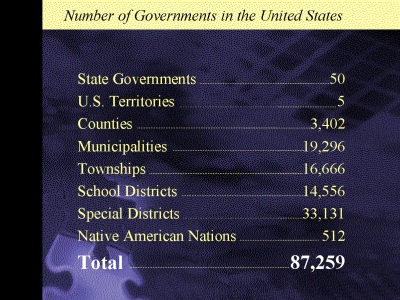 Fig. 1
Fig. 1 Fig. 2
Fig. 2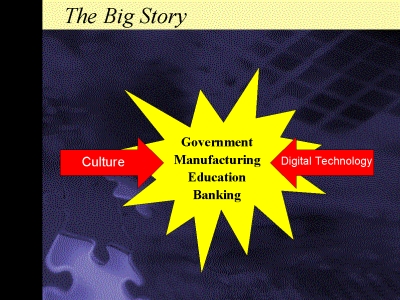 Fig. 3
Fig. 3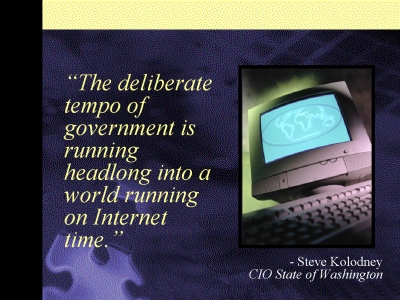 Fig. 4
Fig. 4 Fig. 5
Fig. 5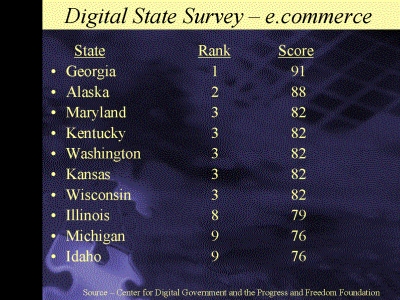 Fig. 6
Fig. 6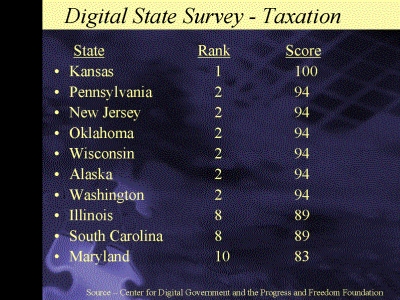 Fig. 7
Fig. 7